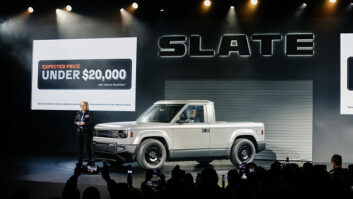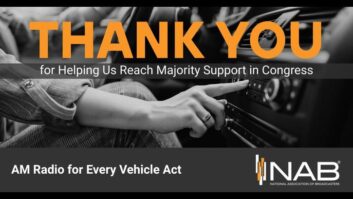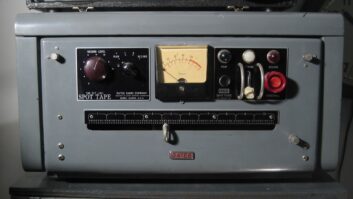
Patrick Hannon is president, WorldDAB.
What’s in store for the radio industry in 2018? Over the next few weeks, we’re publishing a series of interviews with thought leaders from around the globe in various segments of our business. We ask them to weigh in about specific trends and stories they’ll be watching this year. Patrick Hannon is president WorldDAB and VP Corporate Development at Frontier Silicon.
Radio World: What do you see as the most pressing technology challenge facing radio broadcasters in 2018?
Patrick Hannon: The key challenge is to maintain radio’s share of ear in an increasingly digital world. For the United Kingdom, broadcast accounts for 62% of audio consumption (all of which is to radio).
In contrast, online accounts for about a quarter of audio consumption, but only one third of that listening is to radio. As online consumption of audio content grows, radio risks a gradual erosion of listening hours.
To retain its leadership position, radio needs a two-strand strategy. On the one hand, it needs to compete proactively online, through platforms such as Radioplayer — but the overriding priority must be to ensure that broadcast radio remains as strong a proposition as possible.
Radio stations need a strategy where free-to-air broadcast platforms offer compelling and innovative new services. As analogue spectrum is full, the best way of achieving this is to offer listeners exciting new services on DAB/DAB+. In parallel, broadcasters should ensure that DAB coverage is at least as good as FM and new services are promoted effectively.
Data from the U.K. underlines the importance of having a robust digital broadcast platform. Today, digital accounts for 49% of all radio listening (up from 46% a year ago). Significantly, this growth is being driven by DAB (36% of total listening — up from 32% a year ago), whereas online listening has remained flat year-on-year at 8% of total radio hours. For radio to prosper in the coming years, a strong digital broadcast platform is essential.
RW: What consumer electronics trends will have the most impact on how consumers interact with radio and audio media?
Hannon: An obvious area of growing importance is voice-enabled devices. Early evidence suggests that a high proportion of online listening via these devices is to live radio — this is positive news. One word of caution: broadcasters should ensure they do not become over-dependent on the gatekeepers of these platforms.
RW: What do you think will be the prevailing tech trends for the next three years?
Hannon: There will be great excitement about voice recognition and artificial intelligence. Also we will see major changes in the automotive sector with the rise of the connected car. For broadcasters, maintaining a prominent positon in-car will remain a key challenge.
RW: What technology trends or changes should we be watching for as regards digital radio?
Hannon: A key development is likely to be in the area of receiver regulation — an issue where there were several important developments toward the end of 2017.
The most significant was in Italy, where in December a law was passed requiring all radio receivers (consumer and automotive) to be capable of receiving digital transmissions from Jan. 1, 2020.
France has a similar law, which will be triggered when DAB+ coverage exceeds 20% of the population. In a statement published at the end of December, regulator, the CSA, confirmed that this threshold is expected to be passed in 2018.
Support for regulation at a European level is also growing. In October, the European Parliament confirmed its support for legislation in the European Electronic Communications Code (EECC) that would require radios to be capable of receiving digital signals. In December, the German Federal Council (representing the Länder) also announced its support for such legislation.
In total, stakeholders from 11 different countries have asked for receiver regulation. We now enter the “trilogue” phase of EU discussions, which involve the commission, parliament and member states. We expect to see outputs from these discussions later this year.
RW: Norway’s digital radio switchover drew a lot of attention this year, what progress do you expect specifically for DAB+ digital radio in 2018?
Hannon: Established markets in Europe and Asia Pacific will continue to make excellent progress — in particular Germany where we’ll see more news on the second national multiplex and France, which recently announced an acceleration of its DAB+ rollout.
There are also several new countries looking at DAB trials in central and Eastern Europe, the Middle East and Asia Pacific. We’re hoping to see trials and progress in Thailand and Indonesia and, as the large populations of these two countries further explore the benefits of DAB+, receiver sales will grow and prices will continue to fall.
We’re also expecting to see more cars sold with DAB fitted as standard, as all major manufacturers now offer digital radio and the first hybrid radio services are starting to hit the market.
This year we’ll also see the full impact of Norway’s digital switchover, with new listening figures expected in Q1 along with a final report to government and we’re also expecting to hear more from Switzerland on their switchover timetable, currently planned to start in 2020.
For the U.K., 2018 will be a watershed year, when we expect digital for the first time to account for more than 50% of all radio listening. This will trigger a review by government of the UK’s digital radio roadmap.
The challenge will be to balance the needs of listeners, broadcasters and industry. A clear lesson from Norway is that setting a date for digital switchover is a critical factor in focusing the minds and actions of players across the radio ecosystem to achieve a specific goal (i.e. the switch-off of FM).
For the U.K., we need a coherent roadmap which:
1. Sees the ending of the sale of analog-only receivers
2. Meets the expectations of the automotive industry, which has invested heavily in fitting DAB / DAB+ in almost 90% of new cars
3. Sets a timeframe for switchover, whilst ensuring no cliff-edge loss in listening when FM signals are switched off.
RW: How do you expect home and in-car receivers prices to evolve in 2018 ?
Hannon: The growth in the volumes of receivers sold will help deliver economies of scale. For entry-level products, especially in newer DAB+ territories, this is likely to lead to lower prices. For higher spec devices, rather than seeing price erosion, we are more likely to see the inclusion of additional features, such as Bluetooth and voice control, which will enhance the user experience.
RW: Where do you learn about new technology each year, what trade shows or information sources?
Hannon: The WorldDAB General Assembly and Automotive events provide an excellent opportunity to meet new people and hear from a good cross-section of the industry. For other shows and events, we attend IBC, IFA, EBU Radio week along with regional events and workshops and of course keep up to date with Radio World and the latest news from the EBU, ABU and ASBU.







